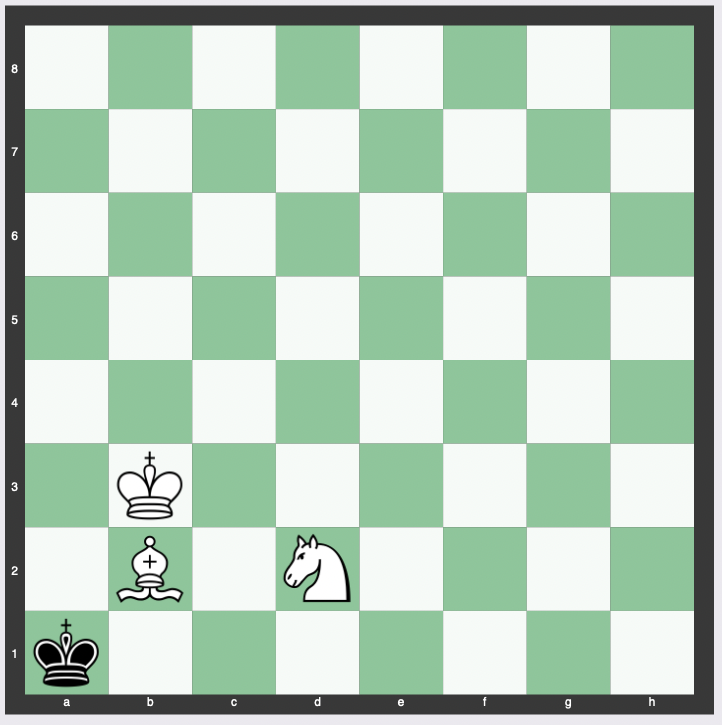The Knight and Bishop checkmate is one of the most intricate endgame techniques in chess.
While it’s a rare occurrence in practical play, understanding the nuances of this checkmate can significantly improve a player’s overall endgame skill.
Knight & Bishop Checkmate – Key Tips
- Coordination is Key: The knight, bishop, and king must work in harmony. If they’re not coordinated, the defending king can find escape routes.
- Get opponent’s king in same color corner as the bishop: To deliver the checkmate, take the color of your bishop. If dark-squared, get the opponent’s king to a1 or h8 (dark-squared corner). If light-squared, get the opponent’s king to h1 or a8 (light-squared corner).
- Use Your King Actively: Your king plays a critical role in controlling squares and driving the enemy king to the desired corner. The checkmate can’t be executed without it.
- Beware of Stalemate: One of the biggest challenges in this checkmate is avoiding a stalemate. Always ensure the defending king has a legal move unless it’s checkmate.
- Practice Makes Perfect: This checkmate requires precision. Regular practice is the only way to internalize the patterns and techniques.
Below we look into the mechanics of this checkmate, offering insights and strategies to help you master it.
The Basic Position
Before diving into the technique, it’s essential to understand the basic position.
The defending king is usually driven to the edge of the board, while the attacking side uses their king, knight, and bishop to coordinate the checkmate.
The Role of the Bishop’s Color in the Knight & Bishop Checkmate
The color of the squares your bishop controls plays a pivotal role in this checkmate.
As we wrote at the beginning of the article – to deliver the checkmate, look at the color of your bishop.
- If dark-squared, get the opponent’s king to a1 or h8 (dark-squared corner).
- If light-squared, get the opponent’s king to h1 or a8 (light-squared corner).
The defending king will be driven to a corner controlled by your bishop.
Example of the Knight & Bishop Checkmate
Take the following position. This is mate-in-26. (We have the sequence of moves at the bottom.)
The first step is to coordinate the pieces.

Bringing the king up helps to cut off space.

The goal is to cut off escape routes for the king.

Here you know you need to get the king into the closest dark-squared corner because the bishop is dark-squared.
So we want it in a1.
This requires bringing in the knight, which wants to get to b4 to cut off escaping out the other side, and forces it down the board.

Protect the knight with the bishop and force the king down the board.

The bishop is taking away upward escape squares, so time to move the knight.

The goal is to flush the king to a1 in this case, so we make moves to funnel it that way.

Moving the king to c2 forces the king to the corner we want it in.

From here, the black king can only go to a1 or a2.
Be sure to avoid stalemate.
Bring the knight to a square where it can protect the bishop, which needs to execute a move to a3, then b2 for the checkmate.

The Ba3 move.

Move the king to b2, then the knight to d2 to force the black king back to the corner to prepare for the bishop to deliver checkmate.

Knight to d2.

Now bishop to b2 to execute mate.

The final position.

The Full Sequence for Knight and Bishop Checkmate
38. Ne3 Kg6 39. Kf2 Kf7 40. Kf3 Ke7 41. Ke4 Kd6 42. Nc4+ Kc6 43. Ke5 Kb5 44. Kd5 Kb4 45. Ne3 Ka5 46. Kc6 Ka6 47. Nc2 Ka5 48. Be3 Ka6 49. Nb4+ Ka5 50. Bd2 Ka4 51. Kc5 Ka5 52. Bc3 Ka4 53. Nd5 Kb3 54. Bb4 Kc2 55. Kc4 Kd1 56. Kd3 Kc1 57. Ne3 Kb1 58. Kc3 Ka2 59. Kc2 Ka1 60. Nc4 Ka2 61. Ba3 Ka1 62. Kb3 Kb1 63. Nd2+ Ka1 64. Bb2#
Kasparov’s Example of a Knight & Bishop Checkmate
At 5:00 of the following video, Kasparov discusses a possible knight and bishop checkmate in one of his World Championship matches against Anatoly Karpov (the fifth World Championship match between them in 1990).
Related: Kasparov’s Insane Calculations
Conclusion
The Knight and Bishop checkmate is a testament to chess’s depth and beauty.
While it may seem daunting at first, with patience and practice, any dedicated player can master this endgame technique.
It’s not just about the checkmate itself but the broader understanding of piece coordination and board control that will elevate your overall game.
Related


